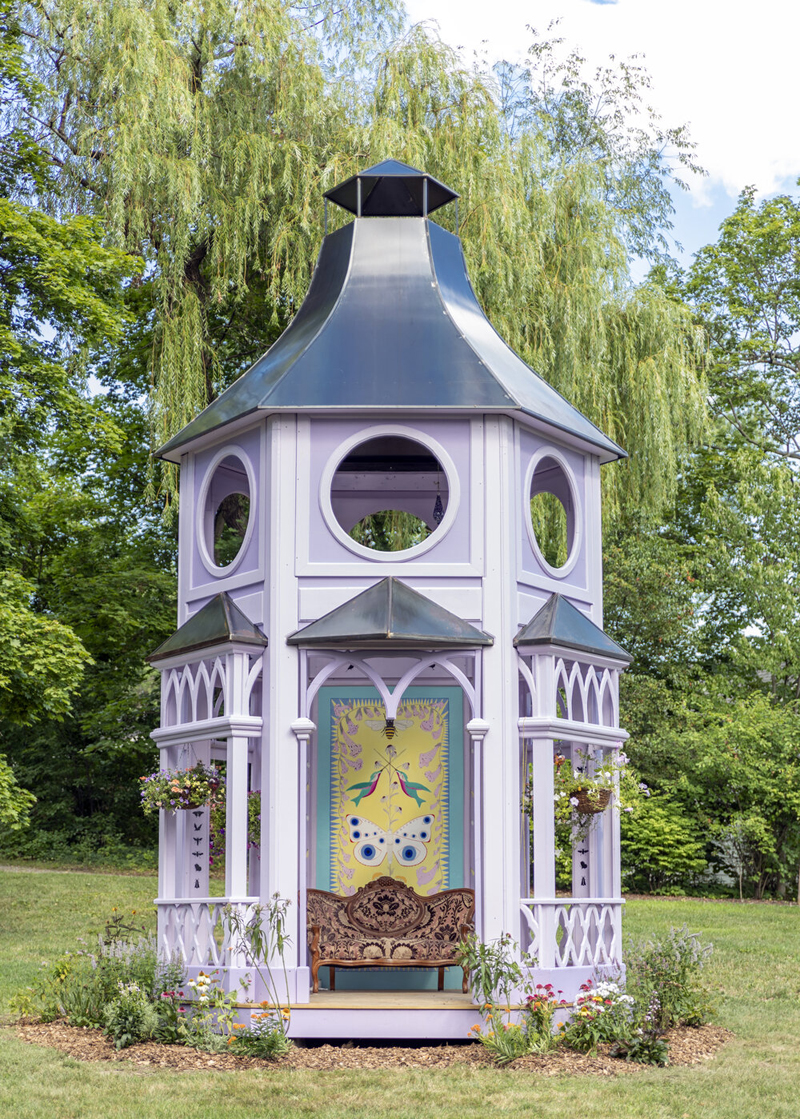

“I think that I will never see/ A poem as lovely as a tree,” Joyce Kilmer wrote in a 1913 poem titled “Trees.” It is a pithy distillation of the common observation that it is difficult to make art that outshines nature. Kilmer’s sentiment might rightly apply to Cross Pollination, a collaborative exhibition that spans institutions and centuries, to put artists in conversation with each other on the topic of ecology — and hummingbirds.
The exhibition is organized between the Olana State Historic Site (once the home of Frederic Church), the Thomas Cole National Historic Site, and Crystal Bridges Museum of American Art in Arkansas. The historic presentations include 16 paintings from a series of hummingbirds and habitats — The Gems of Brazil (1863-64) — by naturalist and painter Martin Johnson Heade (1819-1904). This Audubon-like survey of Brazilian hummingbirds — and the resulting writing on the artist’s part to protest the overhunting of their populations — serves as the aesthetic and philosophical inspiration for a series of new works commissioned for the exhibition. The exhibition also includes paintings by Thomas Cole and Frederic Church, as well as botanical works on both paper and porcelain by Emily Cole, Cole’s daughter, and Isabel Charlotte Church, Church’s daughter. This generational affair also features some highlights from natural specimens collected by Thomas Cole and Frederic Church, including items from the Church family’s extensive collection of bird eggs. The exhibition is presented simultaneously at both Olana State Historic Site in Hudson, New York, and the Thomas Cole National Historic Site in Catskill, New York.
-

Specimens from the Thomas Cole collection. -

Selections from Martin Johnson Heade’s The Gems of Brazil painting series.
With these 19th-century collections that focused so intently on natural systems as their inspiration, a cohort of 21st-century American artists present works in response. The contemporary artists are known to take on issues of biodiversity, habitat protection, and environmental sustainability, and contributions include new works by Rachel Berwick, Mark Dion and Dana Sherwood, Lisa Sanditz and Emily Sartor, and Jean Shin.
On location at the Thomas Cole Site, “The Pollinator Pavilion” is a public artwork by Mark Dion and Dana Sherwood created for the exhibition, where pollinators and humans can share the same space. Jean Shin used the remains of a fallen hemlock tree at the Olana site to create a memorial artwork in its memory, titled “FALLEN” (the tree died of natural causes).

There is a definite poignance to this exhibition, which pits the nascent awareness of human impact on wild spaces evident even in the 19th century to our present-day urgency around climate change and the need for meaningful revision of our relationship with consumption of natural resources. Ironically, though Heade, Cole, and Church advocated for the preservation of natural spaces, the fad of biological specimen collections like the ones being presented fueled a market for hunting the birds that Heade idealized. Even these days, as evidence of our excess mounts in flaming piles on land and sea, it seems we can still hardly even agree that the planet is a finite resource, let alone determine who is entitled to take any little piece of it that catches their eye. Perhaps this exhibition, presenting a conversation long in the having, holds the seeds of change within it. Or maybe we are beyond hope of redemption, and should just enjoy what beauty remains, and — to adopt a quote from another poet, Robert Herrick, in “To the Virgins, to Make Much of Time” — gather ye hummingbirds while ye may. Either way, New York’s Hudson River Skywalk Region seems like a viable place to do so.

Cross Pollination remains on display at the Thomas Cole Site in Catskill and Frederic Church’s Olana in Hudson through October 31. Remember to routinely and thoroughly clean hummingbird feeders, to prevent the spread of diseases that can harm their populations.
0 Commentaires